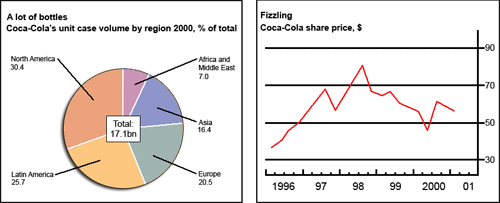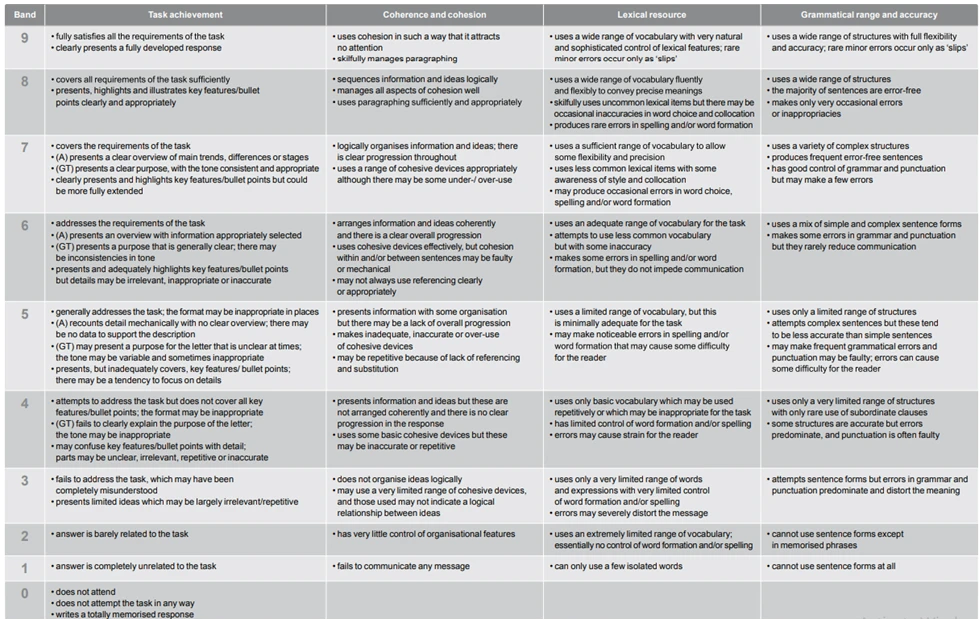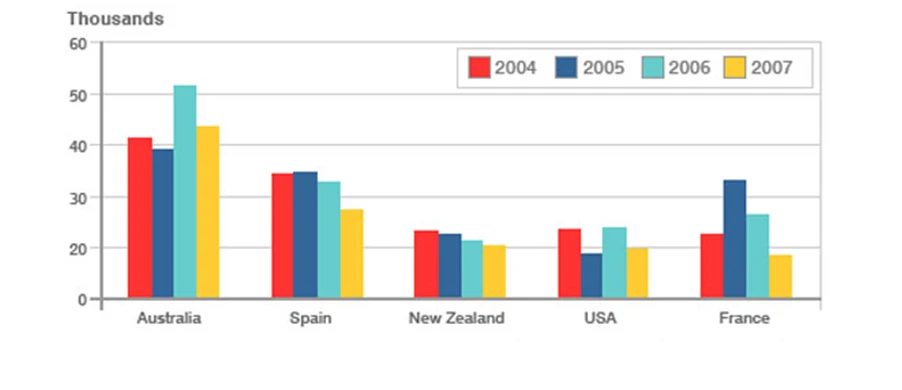Your cart is currently empty!
Category: Academic Training
IELTS Academic training guide for students who desire to migrate abroad for their higher education. Access IELTS online classes and material through our Free IELTS Resources and achieve Band 7.
-

How to Improve Your IELTS Essay Score ?
You’ve just been given your IELTS essay score and it’s not what you were hoping for. Don’t worry, there are still a few things you can do to improve it quickly.
Here are a few tips to help you improve your IELTS essay score:
- Read the question carefully and make sure you understand it before you start writing.
- Make sure your essay is well organized and well written.
- Use strong, relevant examples to support your points.
- Make sure your grammar and spelling are correct.
- Proofread your essay carefully before submitting it.
- Practice, practice, practice! The more you write, the better your score will be.
- Get feedback from others and learn from their mistakes.
Follow these tips and you’ll see an improvement in your IELTS essay score in no time!
Introduction: What Is the IELTS Essay and Why Is It Important?
The IELTS essay is an important part of the IELTS exam. It’s your opportunity to show that you can communicate effectively in English. The essay is worth 25% of your total score, so it’s important to do well.
But don’t worry, you can improve your score quickly if you know what to do. Follow these simple tips, and you’ll be on your way to getting the score you need.
What Are the Main Criteria for the IELTS Essay?
When you’re writing your IELTS essay, there are three main criteria that your score will be based on:
- Task Achievement – how well you completed the task
- Coherence and Cohesion – how well your essay is written and how well it flows
- Lexical Resource – the range and accuracy of your vocabulary
- Grammatical Range And Accuracy – Using correct grammar and adding range of sentence structures.
How to Quickly Improve Your IELTS Essay Score
Tips, on the other hand, are an incredibly important and worthwhile component of this test. Tips are required to inform you of the most difficult and easiest sections of the paper. You can begin your preparation by following the instructions.
Overall, the guidelines give a foundation for the applicants’ preparatory path. It teaches them what to do and how to accomplish it. Let us now move on to tried and true ways for increasing your IELTS writing score.
Many tips are provided below to help you feel confident and at ease with the IELTS exam. It will provide you with information about the beginning and perfect structure of your answers in order for you to impress the examiners and obtain high scores.
Read the Statement thoroughly.
This is critical because if you don’t read accurately, you won’t be able to answer the questions precisely. All applicants must ensure a thorough reading the question. Dont miss to keep track of the keywords, so that you response to the task precisely. This will assist you in processing the meaning of the text. You will comprehend every aspect and become skilled at providing a response.Make a rough outline of the essay.
A basic framework makes it easier to conceive ideas and put them into action. This may appear to be an extra step, but if you have a clear sense of how to approach the issue, it will be quite easy to expand on that.The rough style allows you to easily and precisely transfer your ideas to paper. You can begin writing after first thinking and developing thoughts. It will quicken your writing rate and allow you to include all of the important details.
Make Use of a Variety of Linking Words
Linking words is the simplest basic and grammatically correct way to link ideas, sentences, or phrases in a piece of writing. You must show the examiner a variety of linking terms that are contextually suitable.
Watch out for misspelt words and grammar mistakes.
Nothing ruins an essay more than grammatical mistakes and misspelt words. You must have a keen eye to ensure that your sentences are free of grammatical and stylistic errors, and that your spellings are perfect.
Using Range in grammatical structures
Adding variety in grammatical structures showcase your flexibility in using the language. Using various structures like conditionals, clauses, complex structure, compound structures etcetera sophistically can take your band score in writing to 8.
Read Sample Essays and Get Feedback from expert
When you’re preparing for the IELTS test, it’s important to get feedback on your essays. That’s why we’ve included a few sample essays in this guide, as well as feedback from our expert team.
We’ve also highlighted some of the common mistakes people make when writing essays, so you can avoid them yourself. And lastly, we’ve included a few tips to help boost your essay score.
So what are you waiting for? Start reading!
Conclusion
Follow these simple steps to improve your IELTS essay score and get the result you need.
First of all, read the question carefully and make sure you understand what is being asked. Then, plan your essay carefully before you start writing, making sure you include all of the key points. Be clear and concise in your writing, and make sure your grammar and spelling are perfect. Finally, proofread your essay thoroughly before submitting it.
If you follow these steps, you’ll be able to improve your IELTS essay score quickly and easily.
-

Academic Writing Task 1 sample 2
The chart and graph below give information about sales and share prices for Coca-Cola.
Write a report for a university lecturer describing the information shown below.
» You should write at least 150 words.
» You should spend about 20 minutes on this task.
Sample Answer
The pie chart and line graph reveal the global sales ratio of Coca-Cola in 2000 and its share price between 1996 and 2001.
Overall, It is apparently seen that America was the largest market for this brand. Also the share price of coca cola witnessed an increasing trend despite a minor drop and it was highest in 1998.
According to the pie chart, Coca-Cola sold 17.1 billion unit case in the year 2000 and more than 55% of this sale was made in North and Latin America collectively, latin america being higher compared to the former. Further, They sold around 20.5 billion unit case in Europe, which was their third largest sales ratio. Asian consumers has market of 16% unit case of Coca-Cola in this year and African and the Middle Eastern citizens together consumed 7% of the total sale in 2000.
The line graph shows that the share price of this brand was $36 in 1996 and it rapidly increased in the following years. Except in the middle of 1997, the price kept on going up until it reached its peak at around $80 per share in 1998. Hereafter, the price gradually declined and went below $50 in early 2000. Finally, the share price of Coca-Cola stood at around $60 during the mid-2000.
[carousel_slide id=’16536′]
-

Academic Writing Task 1 Sample 3
You should spend about 20 minutes on this task.
Academic Writing Task : The graph shows the revenues City department revenues from 1959-1966. Summarise the information by selecting and reporting the main features and make comparisons where relevant.
Write at least 150 words
The bar graph illustrates data regarding the city’s income from two different sources (Departmental, the State which includes vehicle tax) for the years 1959 to 1966. Units are measured in tens of millions.Overall, the city received much of its income from departmental revenues throughout the entire time period. Moreover, departmental revenues were either double or more than revenue from the state during this period as well. Another interesting feature is that both sources of income rose steadily throughout the six-year period.
Money collected from the various city departments began at roughly 35 million at the start of the period but dipped the next year to approximately 33 million. From there, it rose until 1962 where it flattened (around 37 million) through 1963. After that year, revenue increased sharply over the next to years to peak at its highest level in 1965 (50 million).
Also Read : IELTS Listening Tips: Sentence Completion or Fill in the Blanks! Learn with 1 Solve Sample.Money paid to the city by the state followed a different trend. In 1966, it was at approximately 12 million and rose until 1961 (around 16 million). Following that year, it dropped slightly in 1962 (nearly 13 million). Then state revenue rose over the course of the next two years, peaking in 1964 at approximately 20 million. From that point, it decreased during 1965 and reached a level similar to that of 1963 (around 15 million)
Practice More and More for Academic Writing Task.
-

Academic Writing Task 1 Sample 4
Academic Writing Task: You should spend about 20 minutes on this task. The maps display the changes made over time in the Village of Stokeford.
Summarise the information by selecting and reporting the main features and make comparisons where relevant.Chart

Write at least 150 words (Academic Writing Task)
The two maps given illustrate how the village of Stockford has changed over a period of 80 years (from 1930 to 2010).
Overall, Stockford underwent significant changes during the 80 year period. The two most significant changes were the change in land use from agriculture to residential. As a result, all land for farming was changed mostly to residential housing. Moreover, the only facilities that remain still remain are the post office and the school.Back in 1930, there was only one road which ran North-South through the village with a side road leading to gardens and a large house to the East.
North of the Gardens and adjacent to them was a primary school. To the north of the school were 7 houses along the main road (4 on the east side, 3 on the west). Just south of the houses on the west side of the road were two shops that were followed by the post office.
South of the post office was two houses and opposite these, one house lay adjacent to the gardens in the north. Surrounding this area was farmland. A little south another road branched west of the main road, and it too is lined with houses.
This all changed by 2010. As mentioned, all farmland was eliminated. Just south of the bridge, a road branched off the main road, and houses were built along with it.
North of this road are three houses and just south of the east road is one house South of the post office on the opposite side of the main road are several houses that and a road branches eas where the entrance to the gardens was. This road is lined with 4 houses and ends at a retirement home.
South of the post office, another road branches west and circles back to the main road. This street is also lined with houses and the street returns to the main road just south of the lane that leads to the retirement home. From this point, both sides of the main road are lined with houses.
Read More :
Academic Writing Task 1 Sample




